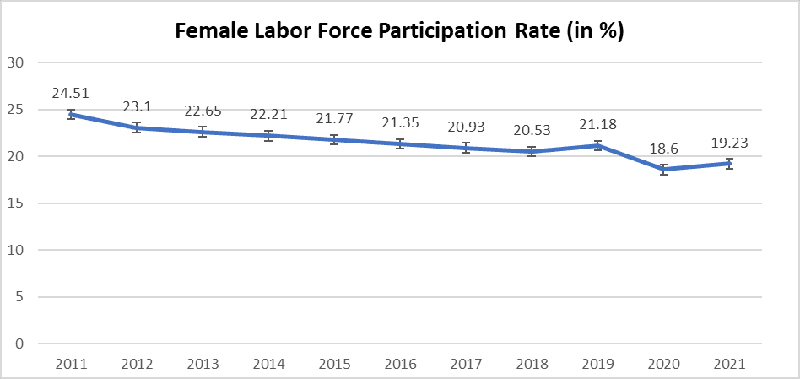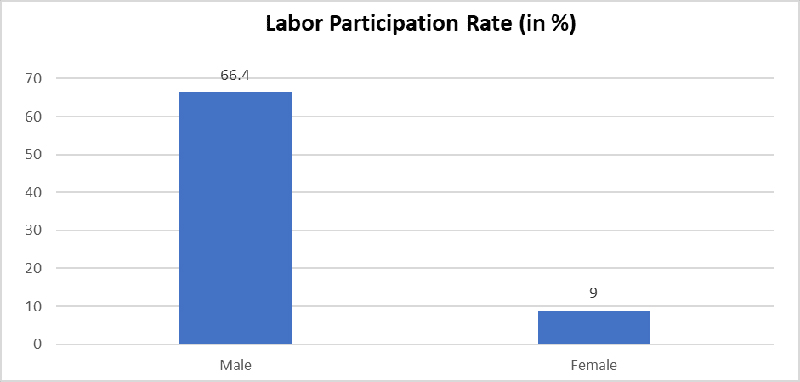 Women
Women
Workplace Harassment: The Truth About Women's Labor-Force Participation Decline
Over the past decade, women's labor force participation has dropped by 5.28 percent (ILO). After providing greater advantages and privileges to women, why is the graph of female participation falling?
According to the UNDP census data released in September 2022 the percentage of women working in India dropped from approximately 36% in 2021 to a little over 33% in 2022. Multiple publications identified many root causes, including the pandemic, increased home obligations, a lack of childcare options due to school closures, and marriage as a barrier. But are those the only reasons? No, one of the underlying reasons we often failed to consider is harassment in the workplace, which causes women to either leave the workforce or be reluctant to enter it.
Female Labor Force Participation Trends
Women account for 48 percent of the population in India, but they only contribute about 18 percent to the GDP, while in China they make up 41 percent. According to the World Bank Report, women in India have one of the world's lowest female labor force participation. Women still aren't actively contributing to the formal economy, despite the fact that the economy has improved, educational attainment has increased, and birth rates have also dropped.
 Source: ILO; World Bank
Source: ILO; World Bank
According to the ILO report , the massive gender gap in LPR is caused by a variety of factors, including rising educational enrolment of young women, a lack of employment opportunities, the effect of household income on participation, and measurement. This massive gender gap in LPR in India, also raises serious concerns about women's inefficiency as laborers to be fit to enter the labor market, as well as the barriers that this labor market offers to women laborers and prevent them from entering the workforce. Many key factors of this disparity remain unaccounted, including workplace harassment against women.
 Source: Centre for Monitoring Indian Economy, 2022
Source: Centre for Monitoring Indian Economy, 2022
The Unaccounted Cause: Harassment
Women have tried to break society's standards by becoming financially independent and working in the government, private, and non-profit sectors, which exposes them to harassment from bosses, co-workers and third parties (indirectly associated with the organisation). As per the National Crime Record Bureau 2021 report, 418 cases of sexual harassment at the workplace or in the office were documented. But these number only indicates one of the harassments. Most people believe that workplace harassment can only be sexual in nature but in reality, there are different categories that belong to different types of harassment, all of which affect the employee mentally, causing humiliation and mental torture that result in decrease in their working capacity and dropout from work.
Correlation between Harassment at Work and Positions of Power
Women face harassment at different stages, and it frequently involves fear because it is about power. In fact, many instances of harassment occur when one person has control over another or when a woman holds an untraditional profession, such as police officer, factory worker, corporate executive, or any other occupation that is traditionally pictured as being done only by men.
Several cases of harassment occur in the workplace, but the victims are afraid to report them for fear of retaliation from their superiors. The fear of filing a complaint against perpetrators of such heinous crimes stems from fear of the boss, fear of confronting guilt in society, not receiving permission from family to re-enter the workplace, fear of being fired or demoted, and fear that it would jeopardize their career by staining their resume and leaving them unemployable. Similarly, some women lack adequate knowledge and are unaware of what constitutes sexual harassment and do not report it.
Mental Harassment
Harassment of any sort done with women employees directly affects their mental health, but in India, any problem related to mental health is treated with very little seriousness and is most times, overlooked. But at the same time, countries such as the United States have celebrated the month of May as “Mental Health Awareness Month" since 1949. It is time for India also to begin discussing mental harassment and supporting its victims. Due to mental harassment in the workplace, it is necessary to promote awareness about mental health issues and disorders among employees and employers. Also, a recent study led by the WHO estimated that depression and anxiety disorders cost the global economy approximately $1 trillion U.S. dollars each year in lost productivity.
What Harassment Does
Women who are subjected to unwanted advances, inappropriate touching, or verbal abuse in their workplace can have a detrimental impact on mental health, including depression. It can also lead to physical and emotional trauma, such as PTSD and decreased self-esteem. Research said women who had experienced the trauma of being mentally tortured and harassed were more likely to have high blood pressure, poor sleep, and significant depressive symptoms and anxiety. The person’s depression can become very serious and even lethal if the situation continues for a long period of time.
Government Efforts to Combat Harassment
The government has taken several initiatives to guarantee the safety of women in the workplace, including enacting the Sexual Harassment of Women in the Workplace Act of 2013. It is undeniable that the laws on sexual harassment in the workplace in India have been effective in providing a sense of security to female employees. As a result, the implementation of strict workplace harassment laws appears to have reduced sexual harassment incidents. However, it's notable that many victims don't file complaints.
Way forward
It is essential to recognize that the full effectiveness of these laws is contingent upon sustained efforts to promote a culture of mutual respect and understanding among employers and employees in India. It is important to ensure that those responsible for implementing the laws are held accountable for any violation of these laws. The government must also provide adequate resources and support to victims of workplace harassment. The government must also ensure that contract workers, domestic workers, agricultural laborers, and others who are not receiving justice from relevant authorities are afforded legal protection against harassment. Additionally, there is no specific law that addresses mental harassment in the workplace, it is imperative that regulations be reviewed.
To encourage women's participation in the economy, all institutions must adhere to existing laws and implement stringent measures against workplace harassment. New recruits should receive a full orientation on their first day that covers the company's harassment policy, how to register a complaint, the status of the complaint, and any disciplinary action. Moreover, during the orientation program, each employee should receive detailed education and instruction on the topic of harassment in the workplace. As a result, the guilty ones will be warned. This method will further promote an environment where everyone, including women, is treated with dignity and respect.
(Pratibha Jain is an Academic/ Research Associate at IIM Ahmedabad. The view expressed in the article is of the author.)
Support Our Journalism
We cannot do without you.. your contribution supports unbiased journalism
IBNS is not driven by any ism- not wokeism, not racism, not skewed secularism, not hyper right-wing or left liberal ideals, nor by any hardline religious beliefs or hyper nationalism. We want to serve you good old objective news, as they are. We do not judge or preach. We let people decide for themselves. We only try to present factual and well-sourced news.







